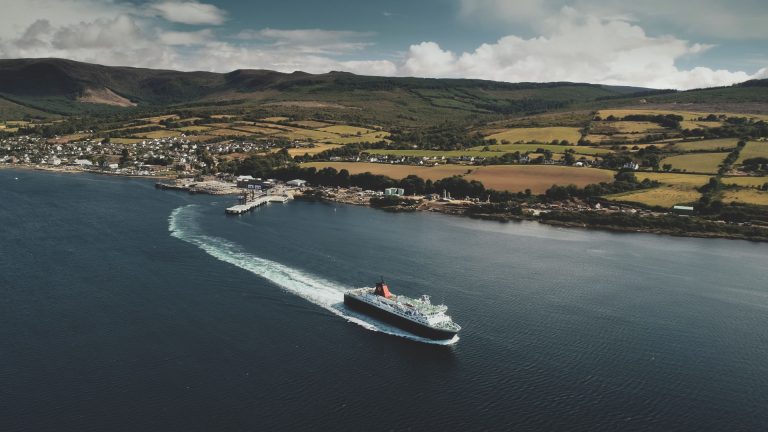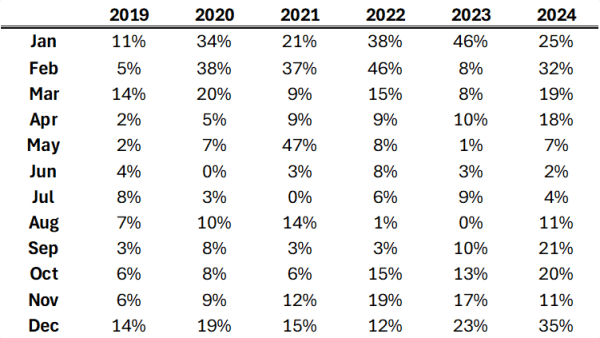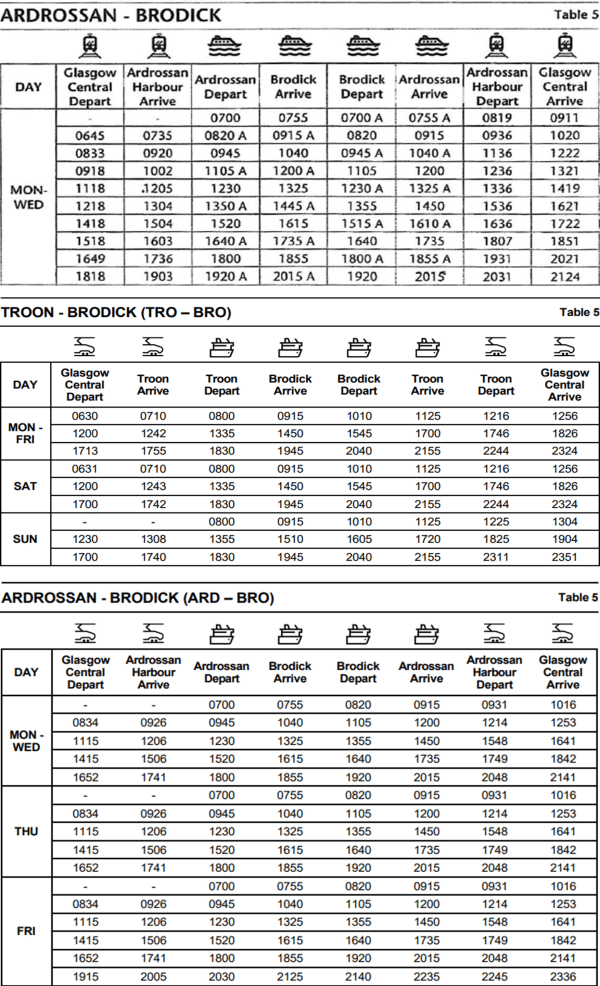Last month, MV Glen Sannox set sail for the first time, closing a notoriously turbulent, drawn-out chapter in the effort to upgrade ferry services between Arran and the Scottish mainland.
Almost 7 years late and vastly over budget, this event will have induced a sigh of relief in many quarters, including at CalMac, CMAL and Transport Scotland. Yet, much uncertainty remains, with Transport Scotland yet to make a firm commitment to the long-term site of the mainland ferry base, following the announcement of a review of the business case in 2023.
Our recent blog looked at the implications of this uncertainty in Ardrossan, which was originally selected as the preferred ferry base. Indeed, by the time MV Glen Sannox arrived, Ardrossan Harbour was expected to have undergone a multi-million-pound regeneration to accommodate Glen Sannox, and its yet-unfinished sister ship, Glen Rosa.
Alas, at the time of writing this regeneration hasn’t even begun, and question marks remain about whether the works will go ahead as promised, or if the temporary switch to Troon will become permanent. A potential breakthrough, however, came in recent weeks when Fiona Hyslop, Cabinet Secretary for Transport, announced that the Scottish Government is exploring the purchase of Ardrossan Harbour – an intervention that could resolve ongoing funding disputes.
While encouraging, this remains merely a glimmer of hope for residents of Ardrossan and Arran. Until a decision is made and work begins, prolonged uncertainty could have serious economic consequences. Even if the preferred outcome is reached, timing is critical.
In this blog, we shift focus to the impact of this indecision on Arran, where the ferry is not just a transport link but a lifeline – connecting residents to employment, healthcare and essential mainland services, as well as facilitating tourism, family ties and local business activity.
Sinking confidence in the ferry service
With Glen Sannox originally supposed to arrive in 2019, the Arran economy has had to deal with adversity for a number of years.
Table 1 highlights the difficulties faced by CalMac in providing a reliable and punctual service, defined in terms of the proportion of journeys that go ahead as planned, and arrive within 10-15 minutes of the scheduled arrival time.
Table 1: CalMac are struggling to provide a punctual and reliable service
Source: CalMac
Years of unreliable ferry services have left some islanders pondering their long-term residency in Arran, with transport disruptions cited as a major factor. Anecdotal evidence highlights the pivotal role of the ferry service not only for residents accessing essential health and social care services on the mainland but also for specialist healthcare providers travelling to the island. The unpredictability of the service continues to undermine access to these critical services.
Table 2: Ferry cancellations are on the rise
Source: Arran Ferry Committee
The economic consequences are equally severe. In a previous study, commissioned by North Ayrshire Council, we found that disrupted ferries cost the Isle of Arran up to £170,000 per day in lost business revenue. This is particularly alarming in light of recent data which showed that the number of ferry cancellations due to repairs has risen by 2000% over the past 13 years across CalMac’s struggling fleet.
This timely revelation came just weeks before the Glen Sannox was due to be pulled from service after only a few weeks for essential repairs to be carried out, and weeks after it was announced that the Glen Rosa could be delayed by another 6 months.
The combination of economic losses, social isolation and threats to essential services contributes to concerns about depopulation, and recent news will do little to restore public confidence in the ferry.
Ferries, trains and automobiles…
With the new vessels too large to berth at Ardrossan Harbour, ferry operations have been temporarily relocated to Troon. However, this shift comes with drawbacks – most notably, a longer crossing time, with journeys to Brodick taking 25 minutes longer than from Ardrossan, and a longer turnaround time between sailings. As a result, the number of daily sailings has been reduced from five to three.
While some may point to the increased capacity of the Glen Sannox as a mitigating factor, this does little to improve service flexibility for shift workers or those relying on ferries for medical appointments. Additionally, although the Glen Sannox is designed to be more resilient in adverse weather, the overall service remains fragile, as displaced vessels from other routes are now covering the shortfall which are still vulnerable, leaving Arran without a truly robust ferry connection.
Over the winter months, MV Alfred has supplemented the service, partially mitigating the shortfall, while MV Caledonian Isles will be operating from Ardrossan from late April 2025, meaning that, although Arran will have more vessels servicing it, it remains without the reliable and robust service it was promised.
A condensed and constrained schedule
With CalMac confirming a two-vessel service from Summer 2025, MV Caledonian Isles will return to service from Ardrossan, while MV Glen Sannox will continue operating from Troon. This represents a capacity increase, providing more sailings compared to the current winter timetable. However, significant challenges remain, particularly regarding frequency, flexibility, and overall travel convenience.
Additionally, ongoing repair delays to MV Caledonian Isles mean it will not be available at the scheduled start of the summer timetable. As a result, Arran will continue to operate on a reduced service over the busy Easter period, with the existing winter schedule remaining in place. During this time, Glen Sannox will operate three return sailings from Troon, supplemented by three additional returns via MV Alfred – both using Troon as the mainland port.
Figure 1 compares a previous summer timetable, provided by the Arran Ferry Committee, with the updated Summer 2025 schedule, showing how the dual-port system alters ferry operations.
Figure 1: The Summer 2025 timetable offers increased capacity but raises new challenges
Source: CalMac, Arran Ferry Committee
Under the revised service, residents now face a fragmented schedule split across two ports, adding logistical challenges. Although there will be more daily sailings, the convenience of travel is still hindered by the longer crossing from Troon, additional transport connections, and limited early morning sailings.
While previous concerns regarding daily sailings have been addressed with this expanded service, the operating hours remain a concern. The final return sailing still restricts how long residents and visitors can remain on the mainland, with the last departure from Troon at 18:30 or Ardrossan at 18:00 (excluding the later Friday night service), cutting short evening activities and limiting flexibility for those travelling for work or medical care.
Furthermore, MV Caledonian Isles, now 32 years old, is beyond its expected operational life, making it increasingly vulnerable to cancellations due to adverse weather or mechanical failures. This undermines the promised resilience of the Glen Sannox, as any breakdowns or disruptions affecting Caledonian Isles will continue to leave Arran residents facing unpredictable and unreliable service.
Added travel hassle and accessibility concerns
The challenges don’t stop with the ferry itself. Unlike Ardrossan, where the ferry terminal is just a one-minute walk from the train station with a synchronised timetable, Troon’s setup is far less convenient. Passengers must now factor in an extra transport mode, taking a shuttle bus to the railway station, followed by a five-minute walk to the platform.
Although CalMac provides a shuttle bus service both to Troon railway station and to the Ardrossan ferry terminal, passengers still face an extra transport mode, adding to travel time and complexity. Anecdotal evidence suggests a strong reliance on services such as dental care in Ardrossan, and yet the shuttle service to Ardrossan only meets incoming sailings from the Glen Sannox, meaning those travelling on the Alfred services must make alternative arrangements to get to Ardrossan – further complicating access to key services and other appointments in Ardrossan and beyond.
Table 3 highlights the difference in transit time travelling from Arran to Glasgow Central, via Ardrossan and Troon.
Table 3: The journey to Glasgow via Troon requires significantly longer transit time than via Ardrossan
Sources: CalMac, Google Maps
Given the rapidly ageing population in Arran and the corresponding heavy reliance on health and social care, efficiency of service and convenience are of paramount importance. Having to travel further in advance, with increased susceptibility to delays, adds unnecessary strain on those who rely on timely medical appointments.
Our previous blog highlighted how Ardrossan is far better equipped than Troon to serve Arran’s population in this regard, with a greater concentration of health and social care workers, both in absolute and proportional terms. Additionally, Ardrossan offers superior transport links to Glasgow city centre, making mainland services much more accessible – particularly for older residents.
Potential government purchase: the light at the end of the tunnel?
Fiona Hyslop’s recent announcement offers a glimmer of hope, reassuring locals in Arran and Ardrossan that the government still recognises the importance of restoring ferry operations to Ardrossan. However, given the government’s track record of delivering capital projects, cautious optimism may be the prevailing sentiment.
Even if the purchase goes ahead, the harbour redevelopment will take at least two years to complete, keeping any benefits far on the horizon. Meanwhile, the longer Arran goes without a reliable ferry service, the risk of severe economic losses grows. For many locals, patience is wearing thin, and waiting years for a solution may not be an option.
Still, this announcement should provide a much-needed boost. A prompt commitment and swift commencement of the works would not only signal tangible progress but also restore confidence in the future. With greater certainty, business owners may finally feel secure enough to invest in the economies of Arran and Ardrossan. Residents and businesses alike will be hoping that this time, action follows words – sooner rather than later.
Authors
Aidan is a Knowledge Exchange Assistant at the Fraser of Allander Institute.





